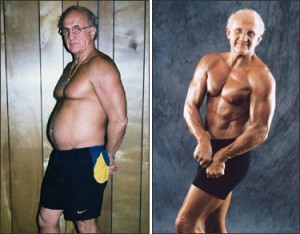 Sixteen years ago, Dr. Jeffry Life was practicing family medicine in Pennsylvania. He was overweight, a borderline diabetic, and so out of shape that he got winded climbing a single flight of stairs. “I wasn’t a very good role model for my patients,” he says. At the suggestion of one of those patients, Life started reading some articles in a fitness magazine about nutrition, getting rid of belly fat, and gaining muscle.
Sixteen years ago, Dr. Jeffry Life was practicing family medicine in Pennsylvania. He was overweight, a borderline diabetic, and so out of shape that he got winded climbing a single flight of stairs. “I wasn’t a very good role model for my patients,” he says. At the suggestion of one of those patients, Life started reading some articles in a fitness magazine about nutrition, getting rid of belly fat, and gaining muscle.
One of the issues featured the winners of a contest called the Body-for-LIFE Challenge. Life was so inspired by the before and after photos that he decided to enter the Challenge himself. He sent in his before pictures, hired a nutritionist and a trainer and got to work. Five months later—and 30 pounds lighter—he sent in his after pictures and became the Challenge’s 1998 Grand Champion. It was one week before his 60th birthday.
Things were going great, but over the course of the next five years, Life gradually started losing muscle mass and strength and began gaining back some of the belly fat he’d lost. He felt sluggish and his sex drive all but disappeared. He had a number of blood tests and found that levels of two hormones—testosterone and growth hormone—were quite low.
Under the care of doctors at the Cenegenics Medical Institute, his energy levels picked up and he again lost weight—especially around the belly. He was so impressed with the results that he decided to switch the focus of his medical practice from family medicine to age management.
We had a chance to speak with Dr. Life, whose latest book is The Life Plan Diet, about his amazing transformation and his commitment to helping men just like him live life to their fullest.
TAMH: Dr. Life, you’re almost 76 years old. How’re doing physically these days?
Dr. Jeffry Life: I’m in the best shape of my life. Most men start losing muscle mass in their 40s and 50s. But over the past 10 years I’ve actually increased mine.
TAMH: How is that even possible?
JL: We now know how important it is for men to not be walking around with low hormone levels. And we know that it’s possible to maintain a great quality of life by correcting deficiencies.
TAMH: How can men find out what their hormone levels are and when should they start paying attention?
JL: We’re talking about andropause, which is like a male version of menopause. If affects all areas of a guy’s life: sex drive, motivation, strength, and so on. I suggest that every man in his 20s get his hormone levels tested. That’s when the levels are at their best. Then, if things aren’t going well in his 30s, 40s, or 50s, we can see whether the levels have changed.
TAMH: What should we be getting tested for?
JL: Every guy should have a good baseline level for total testosterone, free testosterone, IGF-1 (which tells growth hormone status, estradiol, thyroid, PSA, and a few others.
TAMH: Isn’t it possible to stay in shape without messing with your hormone levels?
JL: Sure. If a guy is training right and eating right, he’ll show some progress. But a guy with low testosterone won’t want to go to the gym. If your levels are low, you’re fighting a losing battle.
TAMH: Is there a downside to boosting testosterone levels?
JL: If you’re truly deficient, there is no downside. But you’ve got to be monitored closely by someone who knows what he’s doing. I’m very concerned about all the ads for “low T” where it looks like a doctor is writing prescriptions and not following up. The doctor must look at the patient’s bloodwork at the beginning and regularly during treatment.
TAMH: What kinds of exercises should guys be doing to stay in shape as they age?
JL: Resistance training is great. I like machines over free weights because you’re less likely to hurt yourself. Start with three times per week for 30 minutes, then build up to an hour. If you don’t do weight training, you’ll lose muscle mass and become frail. Frailty is actually the number one reason people end up in nursing homes.
Cardio is also important to work on at least three times per week. Start with 30 minutes and build up to 45. You want something that will get your heart rate up and keep it up. Things like high intensity interval training—where you go all out for one minute, rest for 30 seconds, and do that over and over.
And of course you want to do something to maintain flexibility. The less flexible you are, the more likely you are to fall. Pilates is great and so is martial arts, which also helps with balance.
TAMH: That’s a lot of working out!
JL: The most important thing is to find ways to work exercise into your schedule. People spend too much time sitting around watching TV. You could be working out for some of that time—I love watching action DVDs while I’m on the treadmill. But before you start any kind of strenuous exercise program, you should have a stress test to see whether there are any blockages in the heart.
TAMH: What are some foods that make you age faster—and that can fight aging?
JL: To start with, be careful of bread, potatoes, pasta, white rice, breakfast cereal, fruit juices, and alcohol—one glass of wine per day is okay, but that’s all. I’m also concerned about foods that are high in saturated fats, especially if you have a family history of heart disease.
It’s important to have plenty of veggies and low-fat protein like fish, chicken, and egg whites. I suggest that people eat five smaller meals every day. If you get too hungry, you make food mistakes. And make sure you have good, healthy foods at home. Things like almonds, apples, and peanut butter (the kind that’s peanuts only). Blackberries and blueberries are also good, they’re low glycemic, which means they don’t cause your sugar to spike. You want to keep your sugar levels low and steady.




